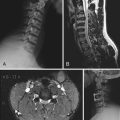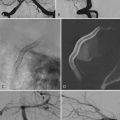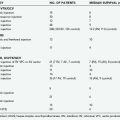CHAPTER 211 Growing Skull Fracture
History and Pathogenesis
Howship was the first to report a patient with a growing skull fracture.1 In 1816, he described a 9-month-old child in whom an enlarging defect in his parietal bone developed after an injury. The defect was apparent within 2 weeks after the injury and never resolved. The boy was re-examined when he was 4 years old and “the opening in the cranium remained undiminished. Upon laying the hand on the part, the pulsations of the brain were felt strong and distinct.”
The first account of the pathology of this condition was by Rokitansky in 1856.2 He reported a 5-month-old who struck his head during a seizure and subsequently an enlarging scalp mass developed. Therapeutic puncture of the mass was performed, after which meningitis developed and the child died. At autopsy a large bone defect was found along with an associated dural tear and injury to the underlying brain.
Sporadic accounts of similar cases were published over the ensuing 50 years. Although the pathogenesis of growing fractures remained obscure, there was clear understanding of the salient clinical features of these lesions. As Godlee wrote in 1885,3
Acting on this knowledge, the first repair of a growing fracture was performed by Sir Charles Balance in 1907.4
Dyke introduced the term leptomeningeal cyst in 1937.5 In an article that dealt primarily with the radiographic characteristics of these lesions, he suggested that after a fracture with an associated dural tear, “loculated, fluid-filled spaces form cysts and, owing to the pulsations of the brain, the overlying bone is absorbed.” Pathologic data confirming this hypothesis were not presented. A similar idea was offered by Taveras and Ransohoff in 1953.6 They reviewed their experience with seven patients whom they had operated on over a 20-year period. All seven had broad dural lacerations with cystic lesions underlying their cranial defects. The authors thought that these cysts were caused by cerebrospinal fluid that became trapped in a herniated section of arachnoid membrane and enlarged because of a ball-valve mechanism. Presumably, the cysts prevented bone reapproximation and, because of their increasing size and the pulsations of the underlying brain, led to bone resorption.
Other observations have failed to confirm the central role of leptomeningeal cysts in the pathogenesis of growing fractures. As part of a larger discussion of skull defects, Penfield and Erickson described a patient with an enlarging defect at the site of a childhood fracture.7 At surgery, brain, but no cyst was found in the defect. Tenner and Stein also described herniated brain within the ossification defects in children with growing fractures and highlighted the importance of local brain injury and swelling in their development.8 Additionally, these authors made the point that porencephalic cysts can be seen in the parenchyma adjacent to the fracture site. This comment predicts the results of Roy and colleagues, who looked more specifically at the microscopic anatomy of growing fractures.9 They operated on 17 patients and presented detailed histopathologic findings from the group. They found that the brain was abnormal in every case with areas of gliosis often admixed with focal areas of necrosis and what seemed to be a combination of old and new damage. Cystic degeneration was common. The authors concluded “… that leptomeningeal cyst formation, emphasized by some workers, does not take place or is extremely rare. Cysts, observed in such cases, generally result from absorption of necrotic brain followed by gliosis. …”
Rosenthal and associates helped clarify the type of injury that is necessary to cause a growing fracture.10 They performed craniotomies in 28 puppies and found that both the dura and arachnoid had to be opened to produce an enlarging fracture and that concomitant injury to the brain did not increase the likelihood that a growing fracture would develop. Clinical confirmation of the finding that dural/arachnoidal laceration, without brain injury, is sufficient to cause an enlarging fracture came from a study by Winston and coworkers.11 They described four patients in whom growing fractures developed after craniosynostosis repair. In only one of the children had a dural laceration been recognized at the time of the first operation; none had any reported parenchymal injuries. At repair, all four were found to have broad dural defects with brain tissue herniating through them. Interestingly, seizures developed in two of the four children, and one of the two with seizures became hemiparetic more than a year after the first operation. The authors thought it likely that these problems were secondary to injuries caused by progressive herniation of the brain through the dural defect.
This concept of delayed or secondary injury is of importance in patients with growing fractures. Although many of the children described have had significant neurological deficits from the time of their injury, there are several reports of progressive dysfunction that develops months or years after the event.11–15 This has been attributed to brain injury caused by (1) local brain herniation and consequent ischemia, (2) repetitive trauma to the exposed brain on the bone edge or by direct concussion, and (3) physical distortion of the brain related to its displacement.9 Winston and coauthors’ report offers important evidence that such injury can, in fact, occur even in the absence of significant preexisting brain damage. Given histologic descriptions of ongoing injury to both the bone and brain in this group of patients, there is strong reason to believe that secondary injury is a clinically significant problem.
Growing fractures occur only in settings in which there is rapid brain growth or, much less commonly, increased intracranial pressure.16 Several authors have speculated on the importance of tissue pulsation in the development of these lesions,16 but there is little evidence to suggest that in isolation, tissue pulsation is sufficient to cause a fracture to enlarge.
Epidemiology
Enlarging skull fractures are extremely uncommon. They account for less than 1% of skull fractures in large pediatric series and, for practical purposes, are never seen in adults.12,17–20 Almost all enlarging fractures are found in children younger than 3 years; two thirds of them occur in children younger than 1 year.6,12,13,15–19,21,22 The parietal region is most commonly affected.13,15,17–19,21,23
No specific or unique mechanism of injury predisposes patients to the development of a growing fracture, but in many cases the trauma suffered seems to have been relatively severe. This probably accounts for the frequency and severity of the neurological deficits found in these patients, greater than 50% in most series, and for the incidence of posttraumatic seizures, which is also around 50%.13,15,17,19
Evaluation
Timely detection of patients with growing fractures requires differentiating those at risk from the much larger group of children with simple skull fractures. The typical patient with a growing fracture (1) is young, with all the patients with enlarging fractures being younger than 3 years and the clear majority being younger than 1 year; (2) has a subgaleal fluid collection overlying the fracture, although the collection may resolve soon after injury23; (3) has a neurological deficit caused by the injury; and (4) has skull radiographs that demonstrate a diastatic fracture with at least 3.5-mm separation of the bone edges.15,22
Recommendations vary on how best to monitor patients in whom a growing fracture is likely to develop after they have been identified. Some authors have advised obtaining skull radiographs 6 weeks and again several months after the injury.6,15,24 It seems equally reasonable to see these patients in the clinic after 8 weeks.17,21,23 By this point, almost all of the growing fractures can be recognized by physical examination. In affected patients, there is a palpable ossification defect, larger than the one initially present, that is usually but not always overlain by a soft, often pulsatile subgaleal collection.16 All these patients will require operative repair. In other patients, the ossification defect is small or only minimally different than it was at initial evaluation, and no overlying collection is present. It is probably best to re-examine these children several weeks later because the fracture may heal without intervention. This group includes a handful of patients who have been described with what has been designated “pseudo-growing” fractures. In these cases, fractures that had enlarged slightly in the weeks immediately after the injury ultimately healed after a few months. Finally, if a child has no skull defect 2 months after the injury, it is quite unlikely that one will develop and the family can be so informed.17,21,23
A number of patients with growing fractures have been described who were not recognized or treated until years after their injury. Each had a large skull defect, usually but not always with an overlying fluid collection. Common initial complaints were pain at the fracture site, epilepsy, and progressive neurological deficit. It is interesting that although some authors have suggested that growing fractures eventually stabilize and the ossification defect stops enlarging, others have not found this to be true. There have been several reports of patients more than 10 years after injury who have had enlarging bone defects and worsening neurological conditions.14
The radiographic appearance of growing fractures has been well described. On plain radiographs, they appear as smooth-edged ossification defects, often scalloped and occasionally, depending on their age, with sclerotic margins.7,12,14,16,19,21,23 Computed tomography (CT) demonstrates the same bony abnormalities and almost uniformly injury and cystic degeneration of the underlying brain.7,14,15,25 Frequently, brain tissue is seen to protrude into the fracture; ventricular asymmetry, with the ventricles drawn to the fracture site, is also common.14,15,19,25 Magnetic resonance imaging adds little but a clear delineation of the parenchymal injury. Angiography is of minimal value in this setting, but reported cases show vessels outside the skull in the bone defect.
Treatment
There is no place for minimally invasive techniques with this condition. A large incision is needed; it must extend well beyond the margins of the skull defect. The skin flap is reflected in the subgaleal plane and the bony defect is defined. The dural edge has a tendency to recede and is often located well back from the edge of the bone. It can be found by progressively removing bone from the margins of the defect until the dura is circumferentially exposed. Alternatively, a bur hole can be placed a few centimeters from the bone edge. A circumferential craniotomy is then performed to allow identification of the dura around the entire lesion. Once the dural defect is exposed, the underlying brain is carefully dissected. If a large area of cortex is herniating through the dural defect, an attempt to reduce it should be made. Some advocate resection of herniated gliotic tissue,18,19,23 but such resection is best avoided in potentially eloquent areas.
Although essentially all authors favor operative repair of growing fractures, one group has suggested that it is not always necessary. Ramamurthi and Kalyanaram described four patients with nonprogressive diastatic fractures.26 None of the fractures healed, all four of the patients were left with ossification defects, but none had progressive neurological problems. The size of the population from which these patients are drawn cannot be determined, and no indication is given on how to decide which fractures will stabilize over time. In any case, spontaneous closure of the skull defect did not occur. Finally, placement of a shunt is best reserved for patients with clear evidence of hydrocephalus, but it does not replace or alter the need for operative repair of these lesions.14,17,23
Bayar MA, Iplikçioglu AC, Kökes F, et al. Growing skull fracture of the orbital roof. Surg Neurol. 1994;41:80-82.
Goldstein FP, Rosenthal SA, Garancis JC, et al. Varieties of growing skull fractures in childhood. J Neurosurg. 1970;33:25-28.
Goldstein F, Sakoda T, Kepes JJ, et al. Enlarging skull fractures: an experimental study. J Neurosurg. 1967;27:541-550.
Halliday AL, Chapman PH, Heros RC. Leptomeningeal cyst resulting from adulthood trauma: case report. Neurosurgery. 1990;26:150-153.
Jamjoom ZA. Growing fracture of the orbital roof. Surg Neurol. 1997;48:184-188.
Keener EB. An experimental study of reactions of the dura mater to wounding and loss of substance. J Neurosurg. 1959;16:424-447.
Scarfo GB, Mariottini A, Tomaccini D, et al. Growing skull fractures: progressive evolution of brain damage and effectiveness of surgical treatment. Childs Nerv Syst. 1989;5:163-167.
Singh FB, Khosla VK, Gupta SK, et al. Growing fracture of the skull: report of an unusual case. Surg Neurol. 1994;42:165-167.
1 Howship J. Practical Observations in Surgery and Morbid Anatomy. London: Longman, Hurst, Rees, Orme and Brown; 1816.
2 Rokitansky C. Lehrbuch der pathologischen Anatomie, 3rd ed. Wien: W. Braumuller; 1856.
3 Godlee RJ. Two cases of simple fracture of the skull in infants, followed by the development of a pulsating subcutaneous tumour. Trans Path Soc Lond. 1885;36:313-324.
4 Balance CA. Some Points in the Surgery of the Brain and Its Membranes. London: Macmillan & Co.; 1907.
5 Dyke CG. The roentgen ray diagnosis and treatment of diseases of the skull and intracranial contents. In: Palmer WW, editor. Nelson’s Loose-Leaf Medicine. New York: T. Nelson & Sons; 1937:185-214.
6 Taveras JM, Ransohoff J. Leptomeningeal cysts of the brain following trauma with erosion of the skull. A study of seven cases treated by surgery. J Neurosurg. 1953;10:233-241.
7 Penfield W, Erickson TC. Epilepsy and Cerebral Localization. A Study of the Mechanism, Treatment and Prevention of Epileptic Seizures.. Springfield, IL: Charles C Thomas; 1941.
8 Tenner MD, Stein BM. Cerebral herniation in the growing fracture of the skull. Radiology. 1970;94:351-355.
9 Roy S, Sarkar C, Tandon PN, et al. Cranio-cerebral erosion (growing fracture of the skull in children). Part I. Pathology. Acta Neurochir (Wien). 1987;87:112-118.
10 Rosenthal SA, Grieshop J, Freeman LM, et al. Experimental observations on enlarging skull fractures. J Neurosurg. 1970;32:431-434.
11 Winston K, Beatty RM, Fischer EG. Consequences of dural defects acquired in infancy. J Neurosurg. 1983;59:839-846.
12 Choux M. Incidence, diagnosis, and management of skull fractures. In: Raimondi AJ, Choux M, DiRocco C, editors. Head Injuries in the Newborn and Infant. New York: Springer-Verlag; 1986:163-182.
13 Pezzotta S, Silvani V, Gaetani P, et al. Growing skull fractures of childhood. Case report and review of 132 cases. J Neurosurg Sci. 1985;29:129-135.
14 Kutlay M, Demircan N, Arin ON, et al. Untreated growing cranial fractures detected in late stage. Neurosurgery. 1998;43:72-76.
15 Tandon PN, Banerji AK, Bhatia R, et al. Cranio-cerebral erosion (growing fracture of the skull in children). Part II. Clinical and radiological observations. Acta Neurochir (Wien). 1987;88:1-9.
16 Ito H, Miwa T, Onodra Y. Growing skull fracture of childhood with reference to the importance of the brain injury and its pathogenetic consideration. Childs Brain. 1977;3:116-126.
17 Johnson DL, Helman T. Enlarging skull fractures in children. Childs Nerv Syst. 1995;11:265-268.
18 Muhonen MG, Piper JG, Menezes AH. Pathogenesis and treatment of growing skull fractures. Surg Neurol. 1995;43:367-372.
19 Arseni C, Ciurea AV. Clinicotherapeutic aspects in the growing skull fracture. A review of the literature. Childs Brain. 1981;8:161-172.
20 Till TK. Paediatric Neurosurgery for Paediatricians and Neurosurgeons. Oxford: Blackwell Scientific; 1975.
21 Kingsley D, Till K, Hoare R. Growing fractures of the skull. J Neurol Neurosurg Psychiatry. 1978;41:312-318.
22 Lende RA, Erickson TC. Growing skull fractures of childhood. J Neurosurg. 1961;18:479-489.
23 Thompson JB, Mason TH, Haines GL, et al. Surgical management of diastatic linear skull fractures in infants. J Neurosurg. 1973;39:493-497.
24 Rothman L, Rose JS, Laster DW, et al. The spectrum of growing skull fracture in children. Pediatrics. 1976;57:26-31.
25 Kashiwagi S, Abiko S, Aoki H. Growing skull fracture in childhood. A recurrent case treated by shunt operation. Surg Neurol. 1986;26:63-66.
26 Ramamurthi B, Kalyanaraman S. Rationale for surgery in growing fractures of the skull. J Neurosurg. 1970;32:427-430.







